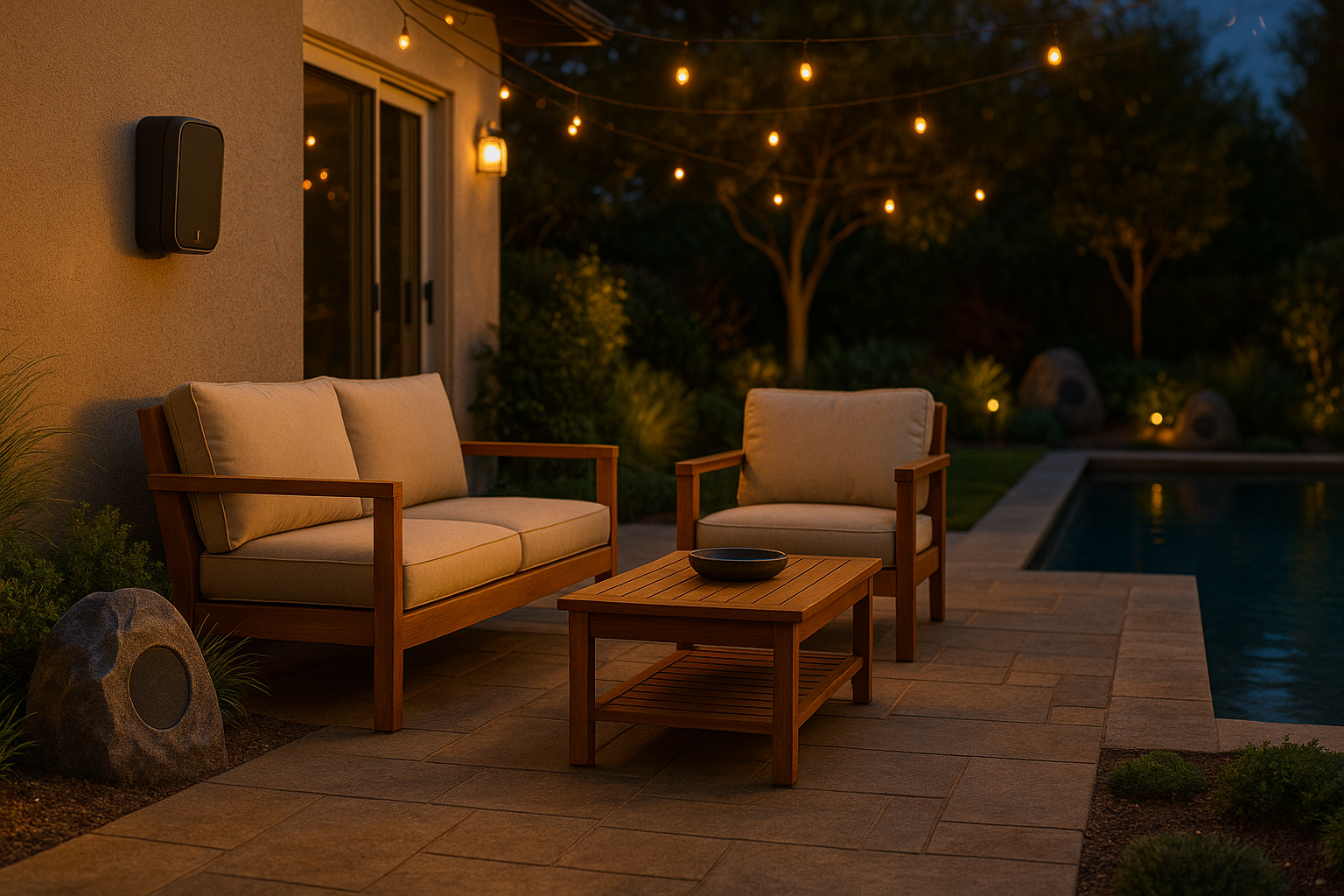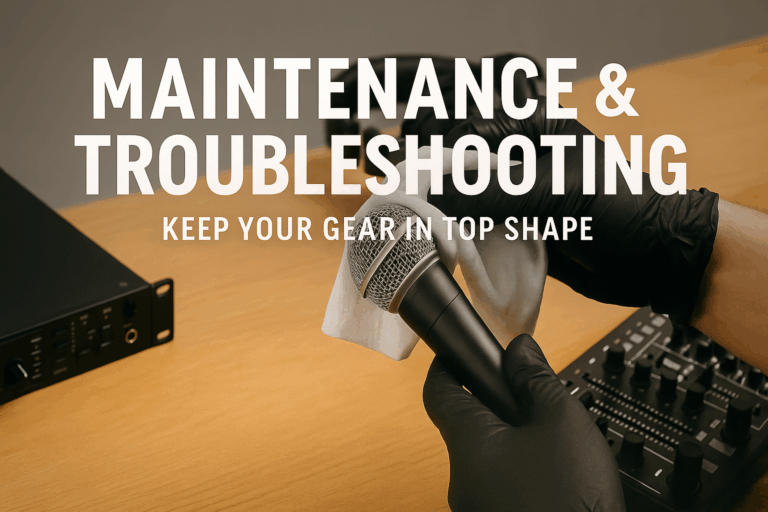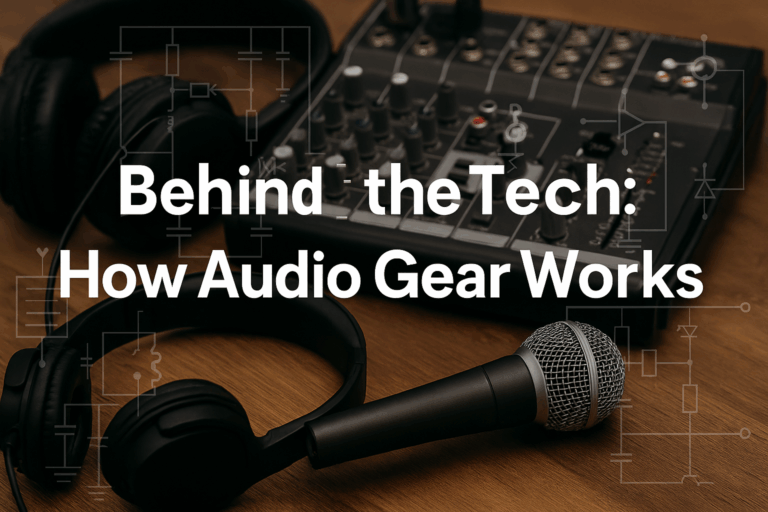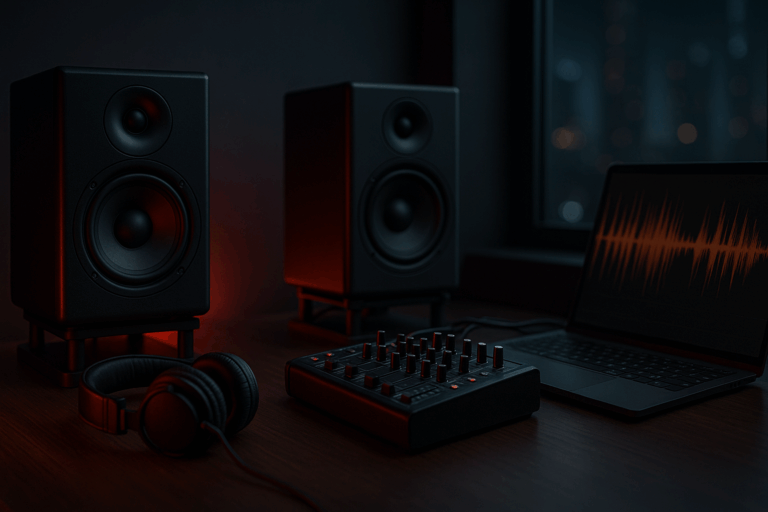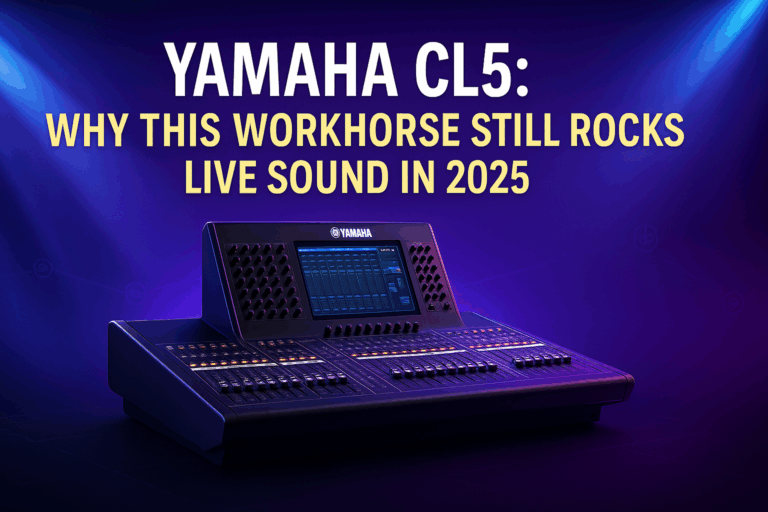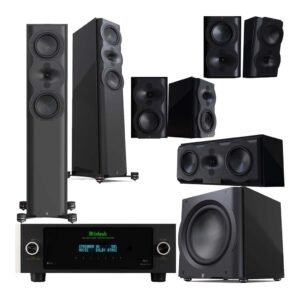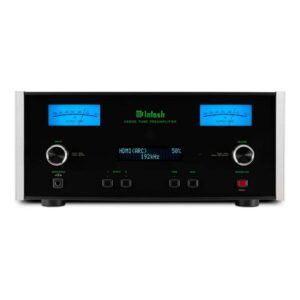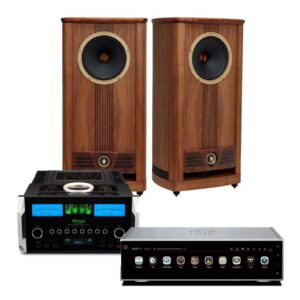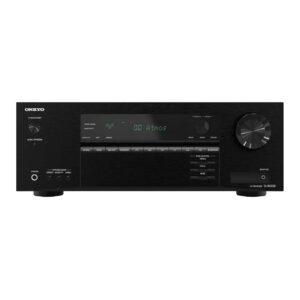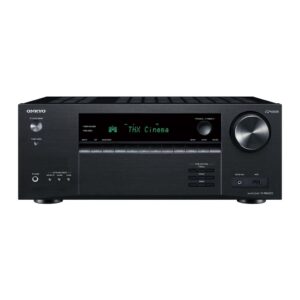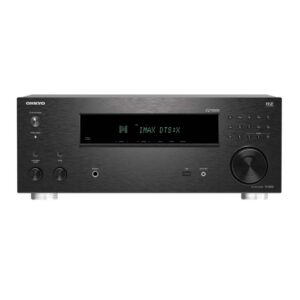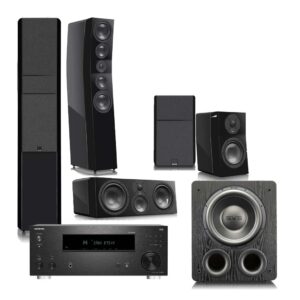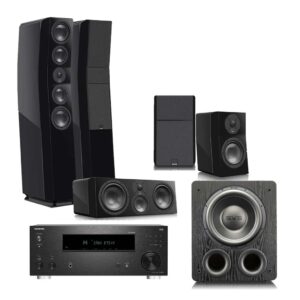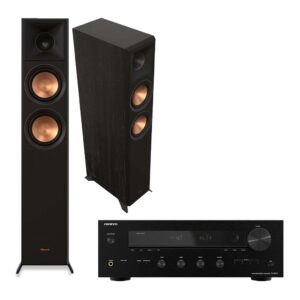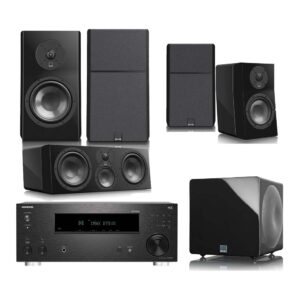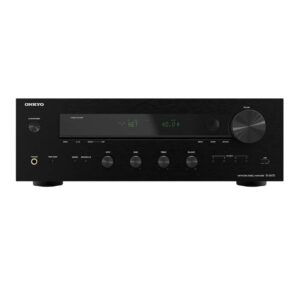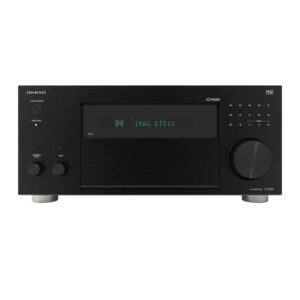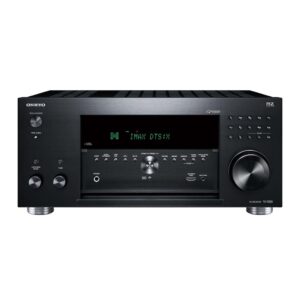Outdoor audio can transform your yard or patio into an entertainment oasis. Whether you’re hosting a barbecue or relaxing by the pool, the right outdoor speaker system provides the soundtrack while withstanding the elements. In this guide, we’ll walk you through everything you need to know – from types of outdoor speakers and key features to installation tips and matching systems to your space – so you can make an informed, confident purchase. InnovateChae offers a full range of outdoor audio solutions, and we’re here to help you find the perfect fit for your needs.
Types of Outdoor Speaker Systems
Understanding the different types of outdoor speaker systems is the first step in choosing the right setup. Outdoor speakers come in various configurations based on how they connect and operate:
Wired Outdoor Speakers (Passive Systems)
Wired outdoor speakers are the classic choice for permanent installations. These speakers connect to an amplifier or receiver via speaker cables. The benefits include consistent audio quality and reliable power since they draw from the amplifier (no batteries needed). Wired speakers often deliver robust sound and can be arranged in stereo pairs or multi-speaker setups around your space. Keep in mind that they do require running cables (often through walls or underground), and proper installation is important for both performance and safety. You might need professional installation or some DIY skills to wire them correctly, but once set up, wired systems are typically very stable with no wireless signal dropouts.
Pros: Rock-solid connection, no signal interference, no recharging or batteries. Can power larger speakers for high-quality sound.
Cons: Requires wiring and possibly an external amplifier. Installation can be labor-intensive, including drilling or trenching for cables.
Wireless Outdoor Speakers (Wi-Fi or RF Systems)
Wireless outdoor speakers use Wi-Fi or dedicated radio frequency to receive audio, giving you more flexibility in placement. These systems often include an internal amplifier (making them “active” speakers) or come with a transmitter that connects to your music source.
No long speaker wires are needed, which simplifies installation. Many wireless outdoor speakers integrate with home Wi-Fi networks or multi-room audio systems, allowing you to stream music from your phone or a media server. Some high-end models can sync multiple speakers together for broad coverage.
Keep in mind wireless doesn’t always mean 100% wire-free – most still need a power source (AC outlet or solar panel) unless they have built-in batteries. They may also require a strong, stable Wi-Fi signal across your yard, or at least a reliable line-of-sight if using RF. Wireless speakers provide convenience but can have limited range or bandwidth issues if your network is weak. Ensure your home Wi-Fi reaches your outdoor areas, or consider mesh network extenders for large properties.
Pros: Flexible placement without running speaker cables, easier to relocate or adjust. Can integrate with streaming services and smart home systems.
Cons: Require power or charging, and depend on Wi-Fi/Bluetooth stability (range can be limited). Typically higher cost per speaker than wired, and you must stay within wireless range.
Bluetooth Outdoor Speakers (Portable Speakers)
Bluetooth speakers are a subset of wireless designed for quick, cable-free pairing with phones and tablets. They are popular for outdoor use because of their portability – many are battery-powered and ruggedized for outdoor conditions. With Bluetooth, you can simply pair your device and start playing music, making these speakers extremely user-friendly. Brands like JBL and Ultimate Ears have led the charge in go-anywhere portable speakers over the last decade so there are plenty of options on the market.
Bluetooth outdoor speakers are great for patios and small gatherings where you want something you can move around. They often feature water-resistant or waterproof builds (with IP ratings, discussed below) and durable rubberized exteriors. Some models offer 360° sound for better coverage in open areas.
Note: Bluetooth range is typically around 30 feet (10 meters) under ideal conditions, and the connection is one-to-one (or one-to-few for certain models’ party modes). This means Bluetooth speakers are not as suitable for whole-yard coverage unless you use multiple units that can sync. For larger areas or synced multi-speaker setups, Wi-Fi based systems or wired systems are preferable.
Pros: Extremely convenient and portable. No installation – just charge them up and go. Many are waterproof and rugged.
Cons: Limited range and one source at a time. Audio quality can be good but high volumes may drain batteries quickly. Not ideal for permanent installation or very large spaces.
Smart-Integrated Outdoor Speakers
Smart-integrated speakers bring voice control and streaming intelligence to your outdoor audio. These systems connect via Wi-Fi and often have built-in voice assistants like Amazon Alexa or Google Assistant, so you can control music and smart home functions with voice commands. Some smart outdoor speakers are essentially weatherized versions of indoor smart speakers, while others (like certain Sonos models) link into your multi-room audio network and can be controlled by apps or voice. For example, portable speakers like the Sonos Move combine Bluetooth, Wi-Fi, and voice assistant capability in a weather-resistant design – offering both smart features and outdoor durability.
When considering smart speakers outside, remember Wi-Fi coverage is essential (just as with other wireless speakers). Also, not all “smart” speakers are fully weatherproof – you may need to place them in covered areas or bring them indoors when not in use if they aren’t built for all-weather exposure. The advantage of smart outdoor speakers is the convenience: you can ask for your favorite playlist, adjust volume, or even control other outdoor smart devices (lights, etc.) hands-free. They can also stream directly from services like Spotify or Apple Music over Wi-Fi, which avoids the range limitations of Bluetooth.
Pros: Voice-controlled convenience and direct streaming. Integration with smart home systems for automation. High-end models have excellent sound quality and multi-room sync.
Cons: Generally require power and Wi-Fi; fewer models are fully weatherproof. Typically more expensive due to added tech. Voice features may not hear you in very noisy outdoor settings.
Internal Linking Tip: When shopping, you can browse by category – for instance, check out InnovateChae’s selection of Outdoor Speakers (wired weatherproof models), Wireless Speakers for outdoor use, Bluetooth Speakers for portable options, and Smart Speakers with Alexa Built-in for voice-integrated models. These categories help narrow down your choices based on the type of system you need. (Consider exploring each section on our site to compare the latest products in that category.)
Key Features to Consider in Outdoor Speakers
Not all speakers are built equal – and outdoor speakers have specific features that are crucial for performance and longevity. As you compare options, pay close attention to the following key features:
Durability & Weatherproofing: Outdoor speakers must withstand sun, rain, heat, and cold. Look for models labeled weather-resistant or all-weather. A good indicator is the IP rating (Ingress Protection rating) which tells you how dust- and water-resistant a speaker is. For example, IPX5 or higher is recommended, meaning the speaker can handle water jets (heavy splashes) without damage. Many outdoor speakers are made with UV-resistant plastics, rust-proof grills, and sealed cabinets for durability. Keep in mind “weather-resistant” is not the same as fully waterproof – most can handle rain and humidity but shouldn’t be submerged. If your speakers are not fully waterproof, plan to install them under eaves or use protective covers during extreme weather. Quality outdoor speakers are engineered to survive harsh conditions (from scorching sun to freezing winters) while still delivering great sound.
Power Handling and Sound Output: Check the speaker’s power handling (usually given in watts) and sensitivity. Power handling tells you how much amplifier power the speaker can take – ensure it matches or exceeds the output of your amp or receiver. A higher wattage capacity is good for large areas, but even more important is the speaker’s efficiency (sensitivity, measured in dB). Higher sensitivity means the speaker plays louder with less power. Consider the size of your area: a bigger yard or a noisy environment (near a busy street, for example) might require speakers that can handle more power so you can get adequate volume without distortion. Many outdoor speakers are “two-way” designs with a dedicated woofer and tweeter, which generally provides clear full-range sound. If you have a very large space or crave strong bass, you might also look into an outdoor subwoofer to pair with your speakers (some outdoor speaker packages include a sub). Always aim for clear, balanced sound rather than just raw volume – the goal is to fill the space with music that complements conversation, not drowns it out.
Connectivity Options: Think about how you will play music through your system. If you have a home audio receiver or amplifier, then passive wired speakers are fine. If you prefer streaming from a phone or using multi-room audio, consider speakers with Bluetooth, Wi-Fi, or smart integration. Some systems even offer multiple input methods (e.g., a wired connection plus Bluetooth). Ensure the speakers (or the amplifier you use) support your desired sources – be it a simple AUX cable from an outdoor TV, a Sonos Amp for streaming, or Bluetooth pairing for quick music from guests’ phones. Tip: For wired setups, you can use an amplifier with Bluetooth or network streaming built-in to get the best of both worlds. For wireless setups, check if the speaker supports the range you need (Bluetooth typically ~30ft; Wi-Fi can cover more area but depends on your router and may require extenders outdoors). Also verify if the system allows expanding – you might start with two speakers and later want to add more for a patio + garden zone. Many modern outdoor speakers can be mixed and matched in a system, especially those on Wi-Fi platforms.
Sound Coverage (Range): Plan for how much area you need to cover with sound. A single pair of outdoor speakers can cover roughly 200 to 400 square feet of area effectively. If you have a larger space (or multiple distinct areas like a patio plus a yard), you will likely need additional speakers or a different configuration. It’s better to have multiple speakers playing at moderate volume than one or two speakers blasting at full volume on the far end of your yard. Consider the speaker’s dispersion pattern: some are directional (meant to aim at a specific area), while others are omnidirectional (radiating 360° to cover a wide circle – great for open lawns). Placement greatly affects coverage – we’ll cover tips on that below. If in doubt, err on the side of a few extra speakers; you can always adjust zones and volumes, but you can’t easily force one small speaker to fill a huge backyard without quality loss. For very large or irregularly shaped areas, you might divide the space into zones with separate volume controls.
Design & Aesthetics: Since outdoor speakers become part of your landscape or patio decor, their appearance and form factor matter. You’ll find designs ranging from traditional box speakers to cleverly camouflaged ones:
Wall-Mount Box Speakers: These look like normal speakers and typically come in neutral colors (white, black) that mount under eaves or on patio walls. They’re not subtle, but many can be painted to match your trim. Choose a shape/size that fits your mounting location.
Rock and Garden Speakers: If you want your speakers to blend in, consider rock-shaped speakers or those hidden in planters. They are designed to resemble natural rock or flower pots while housing full speakers inside. These can be excellent for garden beds, poolside areas, or landscaping where aesthetic harmony is a priority. Planter speakers even let you put real plants on top, serving dual purposes. Just make sure you like the look of them in person – a rock speaker should complement your garden, and you’ll want to pair it with similar stones for the best camouflage effect.
Landscape and In-Ground Systems: These include stake-mounted satellite speakers that poke up from garden beds, or in-ground speakers and subs that bury most of the unit underground (often with only a dome or grille visible). They provide a discreet look and often offer 360° sound dispersion for wide coverage. In-ground subwoofers can add bass without cluttering the surface of your yard.
Omnidirectional and Pendant Speakers: Omnidirectional models are mushroom-shaped units that sit on the ground or mount on a short pole, radiating sound in all directions – great for large open areas. Pendant speakers hang from structures (like gazebo roofs or pergolas) and can be an elegant solution for covered patios with high ceilings.
Smart Display Speakers: Though less common outdoors, there are some weather-resistant smart displays or all-in-one units (think along the lines of an Echo Show-type device or outdoor TVs with built-in speakers). If you have an outdoor kitchen or bar, you might integrate one for both video and audio entertainment. Ensure any such device is rated for outdoor use or installed in an outdoor-rated enclosure.
When choosing design features, also consider mounting hardware and installation needs. Many outdoor speakers come with brackets that allow you to tilt/rotate them. Ensure the brackets are stainless steel or rust-proof. If you’re going for a disguised speaker, check if any additional accessories are needed (for example, some rock speakers require a specific kind of speaker cable that can be buried). Aesthetics are subjective, but with the wide variety available, you can likely find something that sounds great and looks good in your space.
Installation Tips and Ideal Placement Strategies
Installing outdoor speakers correctly is crucial for getting the best sound and ensuring the system’s longevity. Here are some expert-backed installation tips and placement strategies:
Plan Speaker Layout for Even Coverage: Instead of clustering speakers in one spot, distribute them to surround your listening areas. A common mistake is having just two speakers mounted on one side of a patio and trying to blast the whole yard. It’s better to use multiple speakers spaced out, so you get even, ambient sound throughout. A good rule of thumb is to place speakers about 10 to 12 feet apart for balanced coverage. This prevents “hot spots” of very loud audio near the speakers and quiet zones further away. If using stereo speakers, keep each left-right pair within ~10 feet of each other for proper stereo imaging. In large yards, you might alternate left and right channel speakers as you go around the area to maintain stereo sound everywhere.
Mount at Optimal Height and Angle: Mount wall-mounted speakers around 8 to 10 feet high and tilt them downward toward the listening area. This height yields a broad sound dispersion and keeps the speakers safe from easy tampering or accidental spray from sprinklers. Angling them down focuses the sound where people gather (patio seating, pool lounge area) and helps avoid blasting sound toward your neighbors’ property. For ground speakers (like rocks or stakes), placing them at ground level is fine, but try to have them facing upwards or towards the audience area. Always test the speaker direction and listening coverage before permanently installing or burying wires – have someone hold the speaker in place while you listen from various spots, then adjust as needed.
Aim Away from Neighbors and Open Sky: If possible, position speakers so that walls or hedges are behind them to reflect sound toward your area, and point them away from neighbor’s yards. Open-air sound dissipates quickly, so facing speakers inward (toward the center of your space) helps keep the music contained. As one expert puts it, it’s better to use more speakers at a lower volume than a few cranked-up ones – you’ll get clear music and stay friendly with the neighbors. Also, try to avoid pointing speakers straight up into the sky (sound will just escape) or directly at flat surfaces that could cause harsh reflections.
Use Sheltered Locations When Possible: Even if your speakers are weather-rated, placing them under some cover can extend their life. Under eaves, awnings, or pergola roofs are great mounting spots since the speakers get some protection from direct rain and sun. Remember, many outdoor models are “weather-resistant” which means they tolerate moisture but aren’t meant to be soaked continuously. By giving them a bit of shelter, you reduce the chance of water intrusion and sun damage. If a speaker is out in the open, consider purchasing custom covers for them when not in use, or at least during off-season (some manufacturers include grille covers). However, avoid completely enclosing them in a box or airtight space, as they need airflow to sound their best and not overheat.
Secure Mounting and Hardware: Ensure you mount speakers firmly using the appropriate brackets and screws. For wall mounts, anchor them into studs or masonry (use expansion anchors for brick/concrete) so that they can handle the weight and vibrations. Outdoors, wind is a factor – a loose speaker could rattle or even fall. Tighten all bolts and use any included safety cables. It’s wise to periodically check and tighten outdoor speaker mounts (for example, at the start of each season) as temperature changes can loosen hardware over time. If you’re mounting speakers high up, also consider the cable routing – secure the cable along the wall or under eaves to keep it neat and avoid sagging loops that could snag.
Proper Wiring for Outdoor Use: For any wired speakers, use cable that is rated for direct burial or outdoor use. Standard indoor speaker wire will deteriorate quickly outside due to UV and moisture. A common choice is 16-gauge direct-burial speaker cable, which has a thicker insulation jacket. If running wires underground, bury them at least 12 inches deep, or deeper if they cross lawn areas where aerators or shovels might reach. It’s also a good idea to run wires through PVC conduit where possible, even if using burial-grade wire – conduit provides extra protection from water and pests (and makes replacement easier down the line). Always follow local electrical codes for outdoor wiring: some locales require conduit for any external wiring, and others may have rules about burying depth or GFCI protection for amplifiers. If you need to run speaker cable out of the house, use a cable passthrough or external junction box to keep the weather seal intact. Seal any hole you drill with silicone to prevent water ingress and drafts.
Power and Safety: If your setup includes powered speakers or subwoofers that plug into an outlet, make sure the outlet is a GFCI-protected outdoor outlet with a proper weatherproof cover. Never use indoor extension cords outside. Instead, use outdoor-rated power cables and keep connections off the ground (mount them or use a weatherproof box). All electronics (like amplifiers or streaming devices) should be either kept indoors and wired to outdoor speakers, or if kept outside, housed in a NEMA-rated enclosure. Safety first: water and electricity don’t mix, so take precautions to prevent any exposure of connectors to rain or sprinkler water.
Test and Tune: Once everything is installed, do a sound check. Walk around your outdoor space and listen for volume consistency. You can adjust speaker angles or the balance between speakers if one area is too loud or too quiet. Many amplifiers have balance/fade controls or zone volume dials – use them to fine-tune. If you notice excessive echo or harshness in certain spots (perhaps due to concrete patios or walls), consider adding some outdoor rugs, bushes, or other sound-absorbing elements to soften the acoustics. Outdoor audio often means contending with ambient noises (wind, traffic, rustling leaves), so you might need to tweak bass/treble levels to your liking. Don’t hesitate to experiment with positioning early on; small changes can make a big difference in an open environment.
Following these placement and installation tips will help ensure your outdoor speakers not only survive the outdoors but also thrive, delivering great sound exactly where you want it. If you’re not comfortable with aspects of the installation (like running new wiring or climbing a ladder to mount speakers), consult a professional. The team at InnovateChae can also provide guidance or installation services if needed – we want your system to be set up right for maximum enjoyment and safety.
Matching Speaker Systems to Outdoor Spaces
Every outdoor space is unique. A solution that’s perfect for a small tiled patio might not work for a sprawling backyard or a public café terrace. Let’s go through common outdoor environments and discuss what kind of speaker system and setup works best for each:
Patios and Decks (Small Outdoor Areas)
For a small patio, deck, or balcony, you won’t need a large array of speakers – a pair of good outdoor speakers will usually do the job. In a cozy space (say, a deck where you have a dining table and grill), you can mount two speakers on the wall of the house, about 8-10 feet apart, angled toward the seating area. This stereo pair can deliver satisfying sound for dining or lounging without overwhelming the space. If you have a covered porch or pergola, you might even consider in-ceiling or pendant speakers for a clean look – just ensure they are moisture-resistant models if they’re in a humid or semi-exposed area.
On a patio, placement is relatively straightforward: try to face speakers into the patio (toward where people sit). Mount them under the eave if possible to protect them. Patios often benefit from speakers mounted at opposite ends so the sound envelops the area. Because patios are near the house, you can also consider running a speaker wire through the wall to indoor equipment (which keeps the electronics safe inside while speakers play outside). For source control, a popular option is to use a Bluetooth or Wi-Fi amplifier indoors – then you can stream music wirelessly and have the patio speakers connected to that amp. This way, you just use your phone to control tunes outside, with no need to go indoors frequently.
Suggested Systems: A pair of wall-mount outdoor speakers (5-6.5 inch drivers) powered by a small amp is usually sufficient. If you want easy control, use an amp with Bluetooth or network streaming. For very small decks, even a single portable Bluetooth speaker (or a stereo pair of portables) could be enough – just remember to bring it inside when done. Patios are a great place for smart speakers too: if your Wi-Fi reaches, something like an Alexa-enabled outdoor speaker can let you change music by voice while you relax.
Gardens and Landscaped Areas
In a garden setting, aesthetics tend to be as important as sound. You likely want speakers that blend into foliage and decor. This is where rock speakers, planter speakers, or low-profile landscape speakers shine. You can scatter a few rock-shaped speakers among shrubs or along a pathway – they provide pleasant background music that seems to come from nowhere. Planter speakers (which double as plant pots) can sit on the patio corners or amidst flower beds, adding a decorative touch while hiding the tech. In-ground satellite speakers can be tucked along garden borders, barely visible except for a small cap, and many provide 360° sound coverage which is perfect for open garden spaces.
For a medium-sized garden, consider at least 2-4 speakers spaced out. The goal is to create an even blanket of sound. Since gardens often have irregular layouts (winding paths, clusters of plants, water features), think about where people walk or sit the most. Place speakers near those areas, but hidden. If you have tall trees or structures, you could also mount traditional outdoor speakers up high, pointing downward (just as you would on a patio wall). However, many prefer the ground-level approach in gardens to keep the natural look.
One challenge outdoors is bass dispersion – if you love a fuller sound, you might add a buried subwoofer in the garden (some look like short capped pipes sticking out of the ground). These subs can greatly enhance music by providing low-end support, and they’re built to handle being buried or semi-buried. They pair well with small satellite speakers in landscape systems. Keep in mind, a subwoofer will require power and potentially a dedicated amplifier channel.
Suggested Systems: For gardens, look at landscape speaker kits which often come in packages (e.g., 4 speakers + 1 sub, with a matching amplifier). These are often 8-ohm or 70-volt systems. The 70V systems are particularly useful if you need many speakers over a large garden – they allow running a lot of speakers off one amp efficiently (common in commercial gardens or parks) For a home garden, 4 to 8 satellite speakers plus a sub, strategically placed, can create beautiful ambient music that doesn’t seem localized – you and your guests will just “feel” the music around you as you stroll through the space.
Backyards and Large Open Areas
A large backyard (such as a wide lawn or a multi-zone outdoor living space) calls for a more planned approach. Here, you want to ensure coverage across the entire area, possibly divided into zones (like a dining area, pool area, fire pit, etc.). One pair of speakers won’t cut it for a big yard – you’ll likely need multiple pairs or a combination of speaker types. A common strategy is to place several speakers around the perimeter of the yard, all aimed inward towards the center. By surrounding the space with speakers, you can create even coverage without having to blast any single speaker at high volumeabt.com. This setup also keeps most of the sound directed back into your yard, limiting what spills over to neighborsabt.com.
For open areas, consider omnidirectional speakers or speakers on mounting stakes that can be arranged throughout the lawn. Omnidirectional units radiate in all directions, which works great if you place a few in a symmetrical layout (for example, one in each quadrant of a large lawn). Alternatively, you can use multiple traditional directional speakers – for instance, mount a couple on the house facing outward, a couple on a fence or pergola at the back facing inward, etc., to cover from both sides. The key is overlapping coverage so there are no dead zones.
Large areas also potentially need more power. Ensure your amplifier can handle multiple speakers. You might use a multi-channel amplifier or a zone selector to group speakers and control volumes separately (maybe you want the patio speakers louder for a party, and the far-end garden speakers lower for ambient sound). If running a lot of speakers, pay attention to impedance and/or use a 70V system as mentioned, which is ideal for large-scale setups where you might have 6, 8, or even more speakers daisy-chained.
Suggested Systems: For a large residential backyard, you could start with 4-6 speakers. For example, two by the patio, two along the back fence, and two on either side of the yard – all pointing toward the center. Augment with an outdoor subwoofer if you desire robust bass across the space. If you entertain often, you might even consider portable PA-style speakers for events – some modern PA speakers are battery-operated and weather-resistant, giving you temporary boosts of volume for parties. Just remember to dial things back for everyday use; a well-distributed permanent system is better for background music and frequent listening. Lastly, if your yard is truly expansive (think estate or small farm), you may need a professional design with many speakers (here’s where 70V systems and professional installation become important). But for most homes, a handful of well-placed outdoor speakers will do the trick.
Pool Areas and Wet Locations
Pools, hot tubs, and water features present a special case because of the high moisture and reflection off water. For poolside audio, you absolutely want speakers with a strong waterproof rating – ideally IPX6 or IPX7 (waterproof enough to handle powerful water jets or brief submersion). At minimum, IPX5 water resistance is suggested for areas that will get splashed frequently Chlorine and salt (if it’s a saltwater pool) can also be corrosive, so speakers near a pool should have rust-proof hardware and grilles.
A typical setup for a pool area is to mount speakers on the eaves of the pool house or the house wall facing the pool, and possibly have some landscape speakers around planters near the pool deck. Because pools are often open areas, using omnidirectional speakers can help fill the space. Also, sound reflects on water differently – you might find you need a bit more volume or additional speakers to overcome the noises of splashing and the acoustic void a large water surface can create. If your pool area is part of a larger yard zone, treat it as its own zone with dedicated speakers focusing on the pool and lounging chairs.
Safety is key here: keep speakers and wiring clear of direct water contact. All electronics should be at a safe distance from the water’s edge (following any local code requirements for electrical equipment near pools). Many people opt for wireless speakers for pools – for example, floating Bluetooth speakers can literally bob in the water. These are fun gadgets for casual listening, but for high-quality sound, you’ll want mounted or landscape speakers around the pool as described.
One trick: if you have underwater pool lighting or a pool control system, see if it supports any audio features. Some modern pools have integrated speaker systems (rare, but high-end installations exist where transducers transmit sound through the water!). But for most, sticking with above-ground speakers is more practical.
Suggested Systems: Two to four weatherproof speakers around the pool perimeter usually suffice. Position them so that no matter where someone is in the pool, they’re within direct earshot of a speaker (since a single source blasting from one side will lose clarity over the water distance). A pair of speakers at opposite ends of a rectangular pool, angled inward, can work well. If you have a circular hot tub area, one or two small speakers near that zone helps so users can hear without you cranking the main pool speakers too high. Consider speakers that are specifically marketed as marine or pool speakers, as they have extra coatings against salt/chlorine. Brands like JBL, Bose, and others make outdoor/marine-grade speakers that are ideal for poolside use. And yes, you can augment with that fun floating speaker for the novelty of underwater sound – just remember its range and battery life are limited.
Commercial Outdoor Spaces (Cafes, Restaurants, Large Venues)
For commercial or large-scale outdoor spaces, the requirements go up a notch. Here you might be dealing with outdoor seating at a restaurant, a beer garden, a hotel courtyard, or even a theme park area. The focus is on even coverage, durability, and often compliance with safety codes. Usually, commercial setups use a 70-volt distributed audio system. Without diving too deep into technicals, a 70V system allows you to chain many speakers on a single amplifier and use transformers to ensure each speaker gets the right wattage. This is incredibly useful for covering a broad area with dozens of speakers (common in malls, parks, or large patios). The advantage is you get uniform sound and can easily expand the system by tapping more speakers into the line.
In a restaurant patio or cafe, aesthetics and sound quality both matter. You’ll often see small wall-mounted speakers under the awning, providing background music. These might be smaller than what you’d use at home, because they’re meant to blend in and not overpower conversation. Multiple small speakers in a grid can give a nice low-level background audio across all tables. If the space is larger (e.g., a beer garden), a combination of wall speakers and landscape speakers might be used. Pendant speakers are also popular in commercial outdoor settings with structures, since they can hang from open ceilings and provide directed sound to seating areas.
Safety-wise, all equipment in commercial installs should be weatherproof and securely mounted (consider liability – you don’t want anything falling). Wiring often runs through conduits. It’s highly recommended to have a professional design and install commercial systems. They’ll ensure the system meets any regulatory standards (for example, some public spaces might require certain fire-resistant cabling or specific mounting hardware).
Suggested Systems: Depending on the size, a 70V system with several weatherproof surface-mount speakers (from brands like Bose Professional, JBL, Yamaha Pro, etc.) is typical. For example, a restaurant patio might use 8 to 12 small speakers around the perimeter under the roof eve, all running on a 70V amp that provides background music. For a truly large venue (say an outdoor event space or stadium), specialized horn speakers or large-format loudspeakers might be necessary to project sound over long distances – those are beyond the scope of a simple buying guide, but worth mentioning. The key for commercial is scalability and reliability. Trusted commercial-grade equipment can run for many hours each day and withstand abuse. Innovatechae can consult on pro-audio solutions if you’re outfitting a commercial space – we carry commercial amps and outdoor speakers suitable for businesses, and our experts understand distributed audio design.
No matter the space – be it a tiny urban balcony or a sprawling country garden – there’s an outdoor speaker solution that can provide the right ambiance. The trick is to match the system to the environment, both in capability and style. When in doubt, start with a modest system; you can often expand later if needed (especially if you plan ahead by choosing an expandable platform or leaving wiring conduits for future speakers).
Value, Safety, and Trusted Brands
As you plan your outdoor sound system, keep in mind a few overarching considerations: getting good value for your investment, ensuring safety, and choosing trusted brands known for quality. These factors will ensure you end up with an outdoor audio setup that you can enjoy for years with peace of mind.
Value: Value doesn’t just mean the lowest price – it’s about bang for your buck and long-term satisfaction. Outdoor speakers vary widely in price, from budget-friendly pairs to high-end models that cost thousands. Consider how often you will use them and in what conditions. Investing in a slightly more expensive all-weather speaker can actually save money long-term if it lasts many years longer than a cheap speaker that might rust out or fail after one season. The good news is that in recent years, outdoor audio technology has improved greatly: “The quality’s gotten a lot better, and the components last forever,” says one residential AV installer about modern outdoor speakers. In other words, manufacturers have fine-tuned outdoor speakers to ensure longevity. Look for warranties as well – a company confident enough to offer a multi-year outdoor warranty is likely building a reliable product.
To maximize value, think about your actual needs. If you just occasionally play music for small gatherings, you might not need a top-of-the-line audiophile landscape system – a solid mid-range set of patio speakers will be fine. On the other hand, if your outdoor area is your primary entertaining space and you’re an audio enthusiast, spending more upfront for a higher fidelity system (or more extensive multi-speaker setup) could be worth it. Also factor in the cost of amplification and installation. A great deal on speakers might require an expensive amp to drive them, whereas a bundle system might include everything. Package deals (like outdoor speaker bundles with an amp included) can offer good value, ensuring all components are matched.
Another value tip: consider expandability and integration. If you invest in, say, a Sonos Amp and outdoor speakers, you gain the ability to easily add more zones or integrate with indoor speakers later. That flexibility adds value over time. Similarly, a Bluetooth speaker that can daisy-chain to another for stereo might be a better buy than one that stands alone, in case you later want a second unit.
Safety: We’ve touched on many safety aspects in installation, but to reiterate: outdoor electrical safety is paramount. Use the right cables, keep connectors dry, and don’t overload circuits. If you have kids or pets, consider mounting speakers out of reach or using protective grilles – you don’t want little fingers or paws tampering with cone drivers or cables. For wall-mounted speakers, double-check that brackets are secure. Weather events are also a concern: if you live in a hurricane or high-wind area, make sure your speakers (and mounts) can withstand strong winds or consider taking them down during severe weather. Some outdoor speakers come with security cables (tethers) as a backup in case the mount fails – use them.
Also, think about hearing safety for you and your guests. It’s easy to get excited and turn the volume way up during a party, but remember that outdoor environments can be deceiving – without walls to contain sound, you might crank it higher than you would indoors, potentially risking hearing damage if people are near a loud speaker for a long time. Design your system such that no one has to sit or stand right next to a blaring speaker. Spread them out as discussed, and keep volumes at enjoyable, not painful, levels. Many quality outdoor systems produce clear sound that doesn’t require excessive volume to be heard. And if you live in a community, be mindful of local noise ordinances or quiet hours when using your system late at night.
Lastly, secure your investment. Outdoor speakers are sometimes targets for theft (if easily accessible) or can be vandalized. If you’re concerned about this, mount them higher up and out of easy reach. Camouflaged speakers (rocks, etc.) have the bonus of not drawing too much attention. You could also use security screws on brackets that require special tools to remove. This will prevent casual theft. At InnovateChae, we advise customers in public or semi-public installations on how to safeguard their outdoor audio gear – so feel free to ask us for tips if needed.
Trusted Brands: The world of audio has many brands, but a few stand out when it comes to outdoor speaker expertise. It’s wise to choose brands that have a track record in building durable, great-sounding outdoor equipment. Well-respected speaker manufacturers like Focal, PSB, Monitor Audio, Definitive Technology, and Paradigm (MartinLogan) are known for their high-quality outdoor models. These are companies with audio pedigree that have adapted their designs for all-weather use. On the more mainstream side, Yamaha, Bose, JBL, Klipsch, Polk Audio, and Sonos are popular choices for outdoor speakers and are widely trusted. For example, Yamaha’s all-weather speakers and Polk’s Atrium series are highly regarded for withstanding tough climates while sounding great. Bose has both portable and installed outdoor speaker options known for ease of use. Sonos, in partnership with Sonance, offers outdoor speakers that integrate with the Sonos ecosystem, giving you the convenience of app control and multi-room sync, combined with Sonance’s outdoor audio engineering. In portable Bluetooth speakers, brands like JBL and Ultimate Ears (UE) dominate, as they have driven the development of rugged, waterproof speakers for on-the-go use.
Additionally, there are specialized outdoor audio brands such as Sonance, Niles, OSD (Outdoor Speaker Depot), and Tic that focus heavily on landscape and architectural outdoor speakers. These companies often provide innovative solutions like planter speakers or high-performance rock speakers. Sonance, for instance, even makes a “Garden Series” system that includes multiple satellite speakers and a below-ground subwoofer for luxury outdoor sound innovatechae.com. When you see a brand mentioned frequently in positive reviews or used in commercial installations, that’s a good sign of trustworthiness.
At InnovateChae, we pride ourselves on carrying 100% genuine branded products – meaning when you purchase a known brand from us, you can trust it’s authentic and backed by the manufacturer’s warranty. We curate our selection to include brands that deliver value and reliability. If you’re unsure which brand or model fits your budget and needs, our team can share recommendations and personal insights. Often, we’ll point customers to customer-reviewed favorites or our best sellers (for example, weatherproof speakers from Klipsch or Bowers & Wilkins that have proven performance).
Pro Tip: Read up on reviews and consider the environment. A “trusted brand” doesn’t mean every model is identical – some brands make multiple tiers of products. Ensure the specific model you pick has good feedback on outdoor usage. And if you live somewhere with extreme weather, lean towards brands/models specifically advertised as all-weather or marine-rated. These will have that extra engineering for moisture and temperature extremes.
By focusing on reputable brands, you’re more likely to get a product that lives up to its claims (e.g., an IP rating that truly protects). Plus, those brands often provide better customer support and documentation, which can be handy during installation. Remember: a great outdoor speaker system is an investment in your home’s enjoyment. Spending a bit more for quality and durability from a trusted name will pay off when you’re still enjoying music on the patio years down the road, with equipment that looks and sounds as good as new.
Conclusion and Call to Action
An outdoor speaker system can truly elevate your outdoor living – from peaceful evenings under the stars with soft music, to lively weekend gatherings by the grill. By understanding the types of systems (wired vs. wireless, etc.), considering key features like weatherproofing and sound coverage, and following best practices for installation and placement, you’ll be well on your way to creating an outdoor audio setup that perfectly suits your space. Always balance your needs in terms of performance, aesthetics, and budget, and don’t hesitate to consult experts for advice on tricky installations or product choices.
At InnovateChae, we’re passionate about helping you achieve that ideal outdoor sound experience. With our curated selection of outdoor speakers and audio components, we offer options for every scenario – be it a compact portable solution or a full-blown garden sound system. Our team exemplifies the E.E.A.T. approach (Experience, Expertise, Authoritativeness, Trustworthiness), meaning we don’t just sell these products; we know them inside-out and stand behind their quality.
Ready to transform your outdoor space with music? Explore our Outdoor Speakers category on the InnovateChae website to compare the latest models and deals. If you need personalized guidance, reach out to us – we’re happy to suggest products or design ideas tailored to your requirements. From weatherproof patio speakers to smart outdoor sound systems, we have you covered with genuine products and expert support.
Don’t let the season slip by in silence. Upgrade your backyard, patio, or poolside with an outdoor speaker system that will keep the tunes flowing and the good times rolling. With the right setup in place, you’ll enjoy your outdoor areas like never before – all with confidence knowing you made an informed choice.
Contact InnovateChae or visit our online store today to get started on building your perfect outdoor audio experience. We’re here to help you every step of the way, from selection to installation tips. Let’s make your outdoor entertainment as remarkable as your indoor setup – and turn every gathering under the open sky into a memorable one filled with music and joy. Happy listening!

